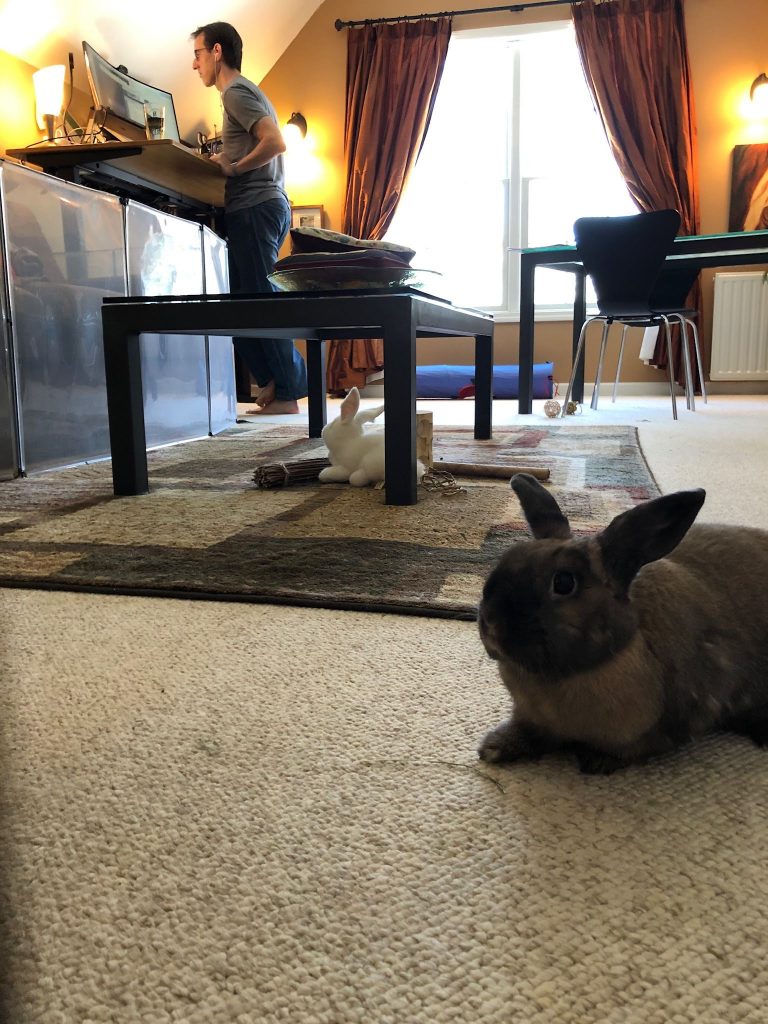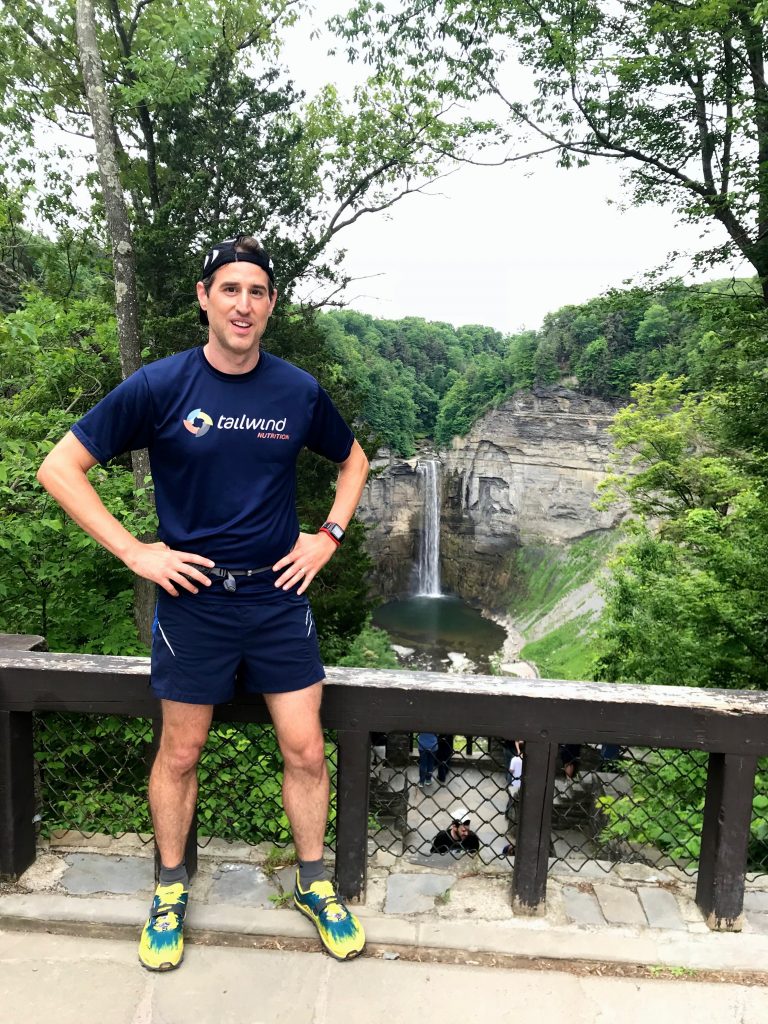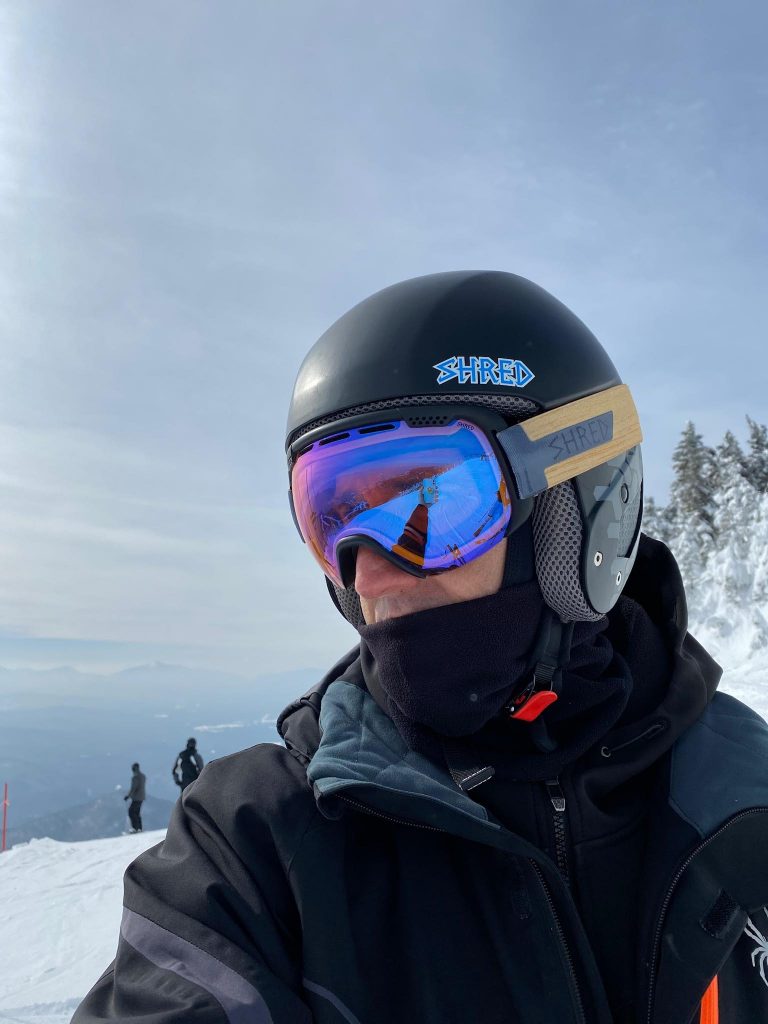1. Hey, can you please introduce yourself?
Hey there! I’m Scott, and I live and work in a small community in upstate New York, about 20 minutes from Ithaca. I’m a web designer and developer by trade, and have worked remotely for Fortune 100 and Fortune 500 companies for 22 years.
I feel really lucky to have the opportunity to work this way. My wife and I built a custom home together, raised two fantastic kids, and enjoy living squarely in the middle of upstate New York’s wine country.
Our region has tons of opportunities for outdoor recreation, too: there are so many places to hike, run, and bike. The Finger Lakes is lush and green in the summer and is brilliantly colored in the fall. In the winter, skiing is our jam: we raised both kids on alpine ski racing, so it’s a wintertime activity that we can all do together now that they’re older.
Cool fact: I have a rabbit in my office at home! Snowball sadly died after living a full and happy life, and now Phoebe is my office companion. If you’re into pets on Instagram, you can follow Phoebe here.

2. What motivated you to choose remote working?
You could call me an accidental remote worker.
I was almost two years into my job in 1998 and I was newly engaged. My fiance and I had looked at housing, commutes, and jobs, and decided that living in New York City wasn’t for us. I was honest with my boss. I told him I was about to be married and wanted to live in another area. I wanted to let him know I was going to be searching for jobs — either an internal transfer or a job with another company. I had no other angle. No other motivation.
He considered what I said. After a few moments he asked, “How would you like to work from home?” He said I was doing a good job for them, and they didn’t want to lose me. I hadn’t considered working remotely, but months later I was working out of a spare bedroom of our new apartment in Massachusetts.
I had a laptop, fax machine, an ISDN line (twice the speed of dialup!) and easy access to New York City if I needed to go into the office for a few days. It was positioned as a 3-month trial, after which I’d return to the office if it wasn’t working out. It did work out, and I continued working remotely at that company for another 15 years.
3. What were your initial months like? Did it live up to your expectations?
Oh, it absolutely lived up to my expectations! It helped that I seemed suited for getting a lot of work done without physically being with other people. I traveled only occasionally to NYC from my home office, so relished in the ability to spend quality time with my wife and settle into our new life together.
Keep in mind, though, that this was 1998. There are so many tools now that support remote work, mostly around collaboration. Slack, social media, and other collaboration platforms vie for our attention throughout the day. These platforms enable a lot of teams to be efficient while being distributed around the world. Contrast that with the lack of sophisticated tools in 1998, and you’ll see how process – regardless of your point in time – is more important than tools.
During those months and the years that followed, my business counterpart and I were collaborating on a web site prototype. I updated a clickable prototype and uploaded my changes to a server. She clicked around the prototype when she was free and printed out the pages to mark them up with changes. Then she FAXED them to me. Yeah, it was the age of fax machines and modems, and it worked great! I made the requested changes and the process repeated. She and I worked so well together! It was the first example I can think of where asynchronous collaboration was as seamless as it could be at the time.
4. How did you find remote working roles?
My first role arose from a conversation I had with my supervisor. So, I literally transitioned my role from on-site to remote, with no other changes.
Over the course of my 17-year career at that first company, I moved from team to team as priorities adjusted and demand arose for my design and usability skills. I really enjoyed the variety of roles, but when it felt like it was time to make a change, I didn’t know how to go about it.
Many of my peers had job-hopped with ease, since it was the heyday of the dot-com era. I had not, preferring to view myself as a “lifer.” I tapped my network casually over the course of several years, and one of my prior managers responded to me with a promising lead. He was at a different company and had a job opening that, while not advertised as remote, could be done remotely.
He knew my reputation for doing good work while distributed. Months later, after several rounds of phone and on-site interviews, I was on location in NYC for the first week of my second job after graduate school. I think it’s amazing that I’ve only worked for two companies during my 24 year career, but it’s also a sign of one of the benefits of remote work for me. I find that my stress level is lower, my job satisfaction is higher, and the balance of work and my personal life is, well, more balanced. All of that makes me content to stay where I am and continue to do good work!
5. What have been the best, good and worst aspects of remote working for you?
I find it easier to be healthy and active as a remote worker, and those easily top the list. I run most days of the week, mixing in weight training, yoga, and other cardio when I can. That would be far more difficult if I had to grapple with a commute.

Plus, I can time my run to coincide with better weather, not having to worry about getting cleaned up and dressed up to resume work. I also find that my stress level is significantly reduced as a remote worker. As a result, I’ve enjoyed being a far more engaged father and husband.
Professionally, I enjoy the ability to do good work during stretches of uninterrupted time. I am a fierce guardian of my schedule, and prefer to group meetings together so the longer stretches of my day aren’t interrupted. In an office environment, interruptions from others around you are inevitable. At home, I have far more control over them. And that’s a good thing.
Drawbacks exist, of course. Loneliness and isolation can be real problems, and they have been for me at times. I find that during times when my family is not around, I have to be far more intentional about making plans with others, and practicing self-care.
Professionally, I’ve found that some managers assume that I can’t be an effective leader because of my geography. As a result, I’ve been passed over for promotions. I’ve viewed that as a necessary trade-off for what is inherently a net positive lifestyle. And, I know from my own resume that I’m an effective leader: I remotely led distributed teams for a significant portion of my first job.
At the moment, I’m happy being an “individual contributor,” taking leading roles though I technically don’t have any direct reports.
6. What tools do you swear by while working remotely?
Tools come and go, so I’d be doing our future selves a disservice by naming them. The tools that are most useful to me are the soft skills that are table stakes for any remote worker. The two I’ll call out specifically are communication and discipline.
Communication is so critical. It’s important to be vocal about what you’re working on, what you’ve accomplished, and whether you need anyone’s help to make more progress. How you communicate is just as important as what you communicate. Consider your audience, optimize the logic and structure of your message, and ruthlessly edit so you’re not using more words than necessary. I’m equally comfortable presenting to C-level executives, external clients, and technology-oriented peers, though I speak to them in totally different ways. The best way to get better at communication is to constantly practice and refine your techniques.
Exercising discipline is a close second for me, skill-wise. Certain people might be naturally more disciplined than others, but discipline can be learnt and perfected. In an office environment, expectations are set. You know when your day is supposed to start and end. You know after what arrival time your manager will raise their eyebrows, and you know before what departure time they’ll pull you aside and say, “Exactly where is it you have to be?”
During the workday, the eyes of your colleagues and your manager keep you on task and mostly in your seat, unless you’re in a meeting, on your way to a meeting, or on your way back from a meeting. When you’re remote, all bets are off. You can start when you want. Finish when you want. Go for a walk when you want. Chances are, your manager and peers won’t notice. And that’s okay! In the grand scheme of things, it doesn’t matter. What matters is that you get your job done, and your own discipline is the way that’ll happen.
It’s up to you to structure your day most effectively. If you know you focus better in the morning, prioritize the work that requires focus for that time. Whenever those times of day are for you, screen out distractions and be productive. Discipline isn’t just about avoiding the things that suck time and productivity from your day. It’s also about ensuring you do the things that enrich your life and bring you joy! It may be fitness, something social to keep those connections happy, or a hobby you’re actively feeding. Make the time and be disciplined about it.
7. Your most exciting/ hilarious experience since you started working remotely.
There’s very little hilarity in working remotely, at least for me, so this question is a little tough to answer. I’ll opt for an exciting story, and it’s peripherally related to work.
People around me say I live intentionally, which to me means that I set realistic, challenging goals and embed them into my daily life. It may be small, such as focusing on doing pushups every day, or larger, like spending a half hour writing every morning with the goal of publishing a book.
One of the projects I did that brought me the most joy and excitement was drawing every single day for a year. After doing that in 2016, my #365DayDraw project was impressive enough to hang as an art exhibit in local coffee shops. With a few exceptions (I remember two), each day’s final drawing was the first drawing.
I trashed a few pages since it started off SO awful, but I really thought about what I’d draw most times, and if it didn’t start off well, I tried to evolve it until it finished well. Sometimes that resulted in some interesting abstractions. Looking back, I remember the circumstances around each drawing: where I was, what I was thinking, and if the accompanying quote on Twitter preceded or was inspired by the drawing.
My commentary on my drawings were sometimes trite, sometimes humorous, and sometimes deep. As I went through each month, I realized that the project was less about the art and more about inspiring conversation. I enjoyed engaging with different people about the drawings, and also the chance to share my work in person with whoever I thought would enjoy a particular day’s subject matter.
8. What is your golden advice to a new remote worker?
Oh! An opportunity for a shameless plug? Okay … read The Art of Working Remotely. It’s just a few dollars, and will probably be the best investment you can make to –
a) make yourself laugh, and
b) pick up some practical tips that can help you optimize your remote workday.
Why did I write a book? I honestly hadn’t thought about it until one of my colleagues started working remotely and expressed doubts about his ability to do so effectively. He asked me how I did it so well as we were instant messaging back and forth. After I answered his tactical questions, he suggested sharing this information more widely. I agreed. That conversation was the catalyst to start writing!
I thought it would take a long time to write the book. I committed to write every weekday morning for a half hour. My wife and I wake up before the kids and do personal, creative things before we’re all together. I wrote the book over the course of 6 months.
After writing a combination of personal anecdotes and practical advice, the title came to me easily: “The Art of Working Remotely”. Art is inherently subjective, and we all approach life with the context and experience from the days that came before this one. I wrote stories that impacted me as a person. I wrote stories that resulted in takeaways that I think anyone can benefit from. That’s very much a part of the context that I bring to the table when I show up to work each day. Your stories will impact how you approach your job, just as mine did.
9. How do you see your career shaping up and your goals?
I’m squarely in the middle of my career, and I think things have shaped up just fine.
My kids are late in high school and into college at this point, so my wife and I have an eye toward the future. It’s exciting to think about what it may hold in store for us!
I’ve also seen my priorities shift, and lately I’m more excited about doing creative things like writing, singing, or creating art. The spectre of the coronavirus pandemic has injected a fair amount of stress into my life, but the routines that I enjoy and the time I am spending with my family are keeping me fairly centered.
I keep reminding myself that every day is a new day, and new challenges will always present themselves, no matter how stable you thought your life or career was.

10. How do you expect remote working to evolve in the future?
Will companies and institutions embrace remote work more readily after this coronavirus crisis passes? This large remote work experiment may move the needle in that direction, but I’m not optimistic about a wholesale shift.
People are inherently drawn to other people, and in some segments, that may override any perceived benefit of a fully-remote model. That said, there are many successful hybrid models, where people come together periodically to collaborate in person (whether for a few days, or for an offsite if everyone is normally remote).
Regardless, everyone will have learned lessons from this experience. Remote work was on the rise before this happened, and the trajectory will no doubt continue in that direction when things return to whatever we deem “normal” in the future. I think the only remaining question is the degree of change in the amplitude.
11. Where can we follow you on?
My personal website is at scottpdawson.com, and it’s a mix of personal, technical, and fitness-oriented posts.
I’m most active socially on Twitter, and you can find my professional profile over on LinkedIn.
I have most of my fun over on Strava, though. If you’re a runner or cyclist, I’d love to keep up with what you’re doing there! Lastly, learn more about The Art of Working Remotely at artofworkingremotely.com/book.
Are you a remote worker too?
Would you like to share you story?
Just reach us at hrishikesh@remote.tools!